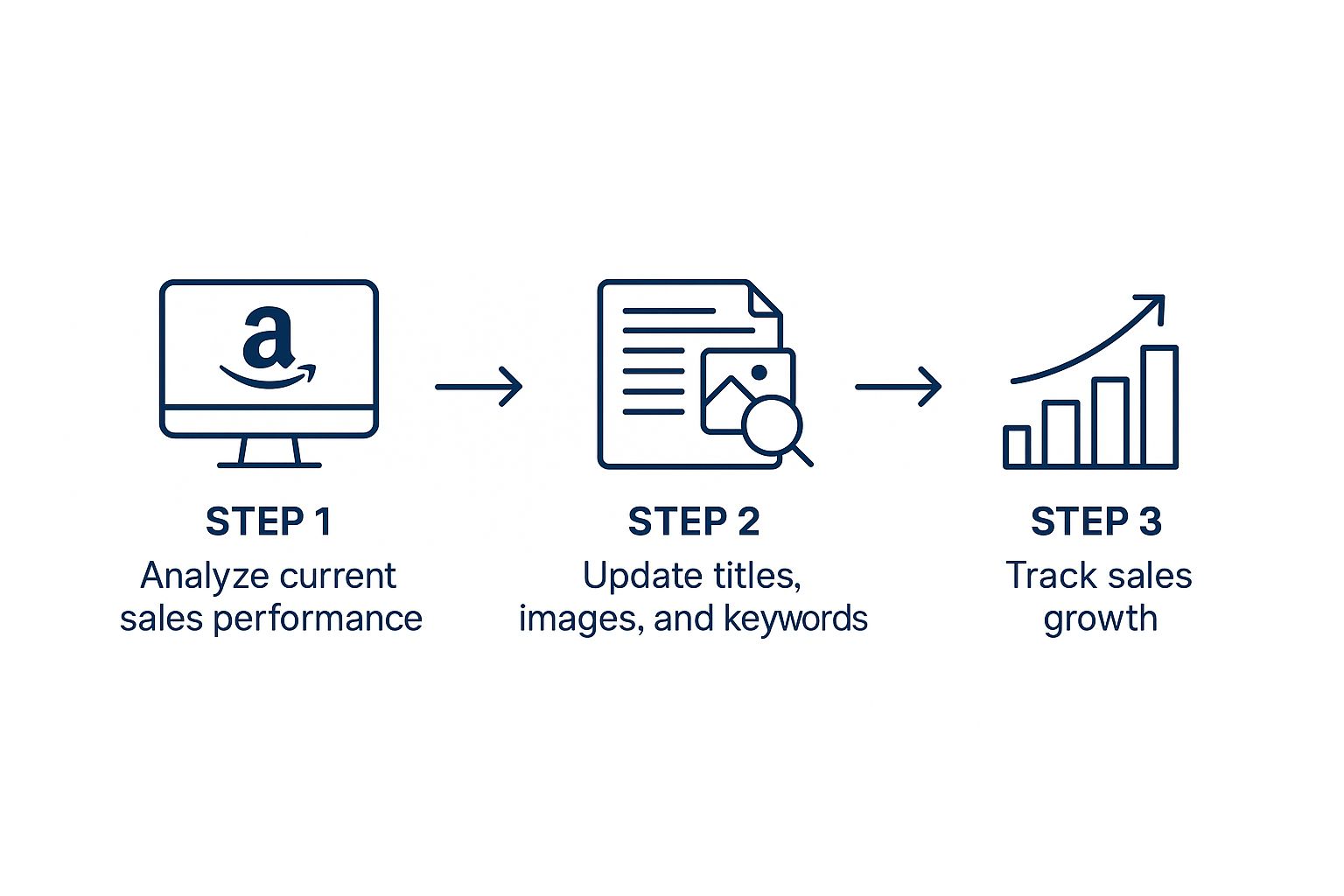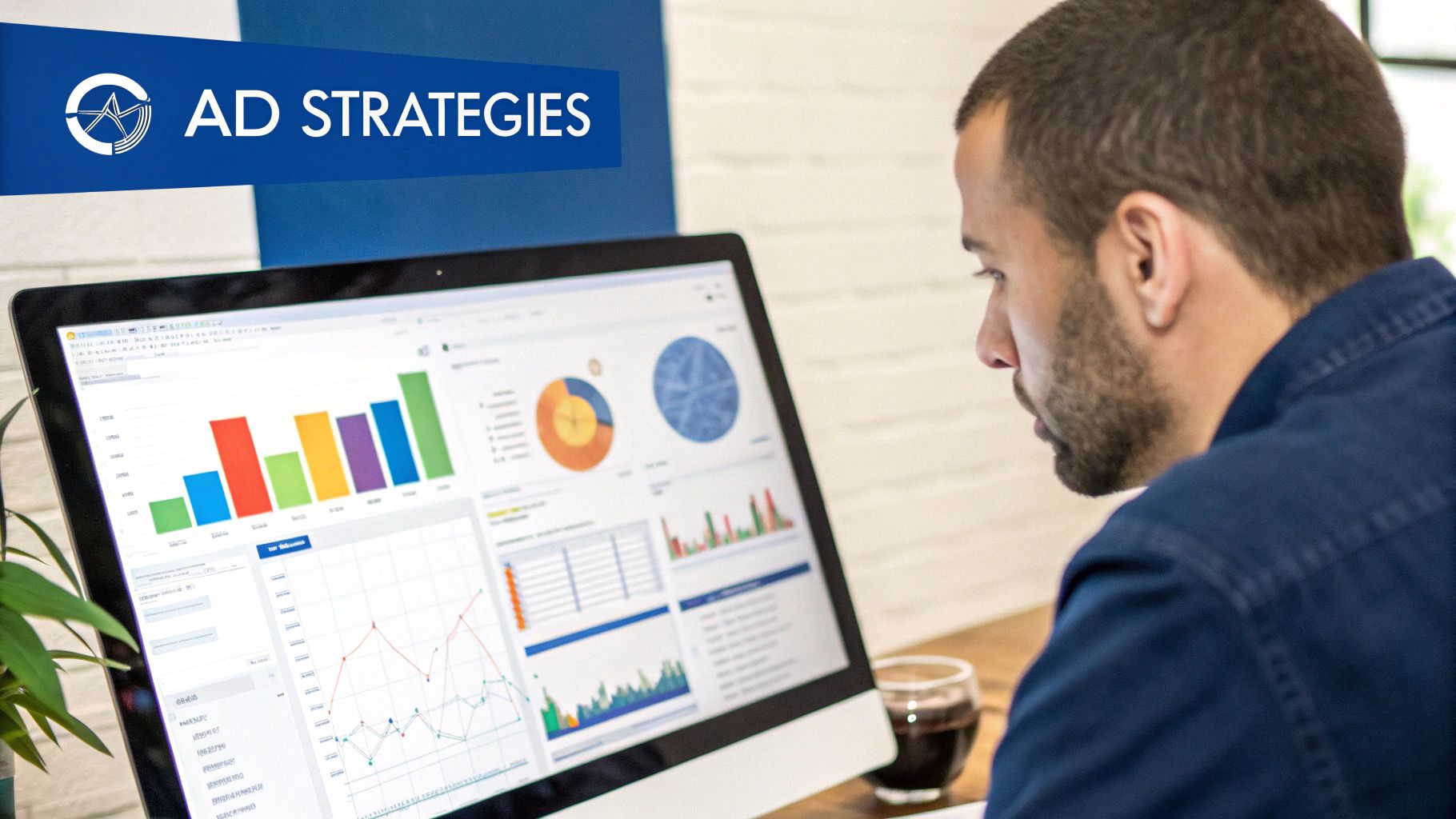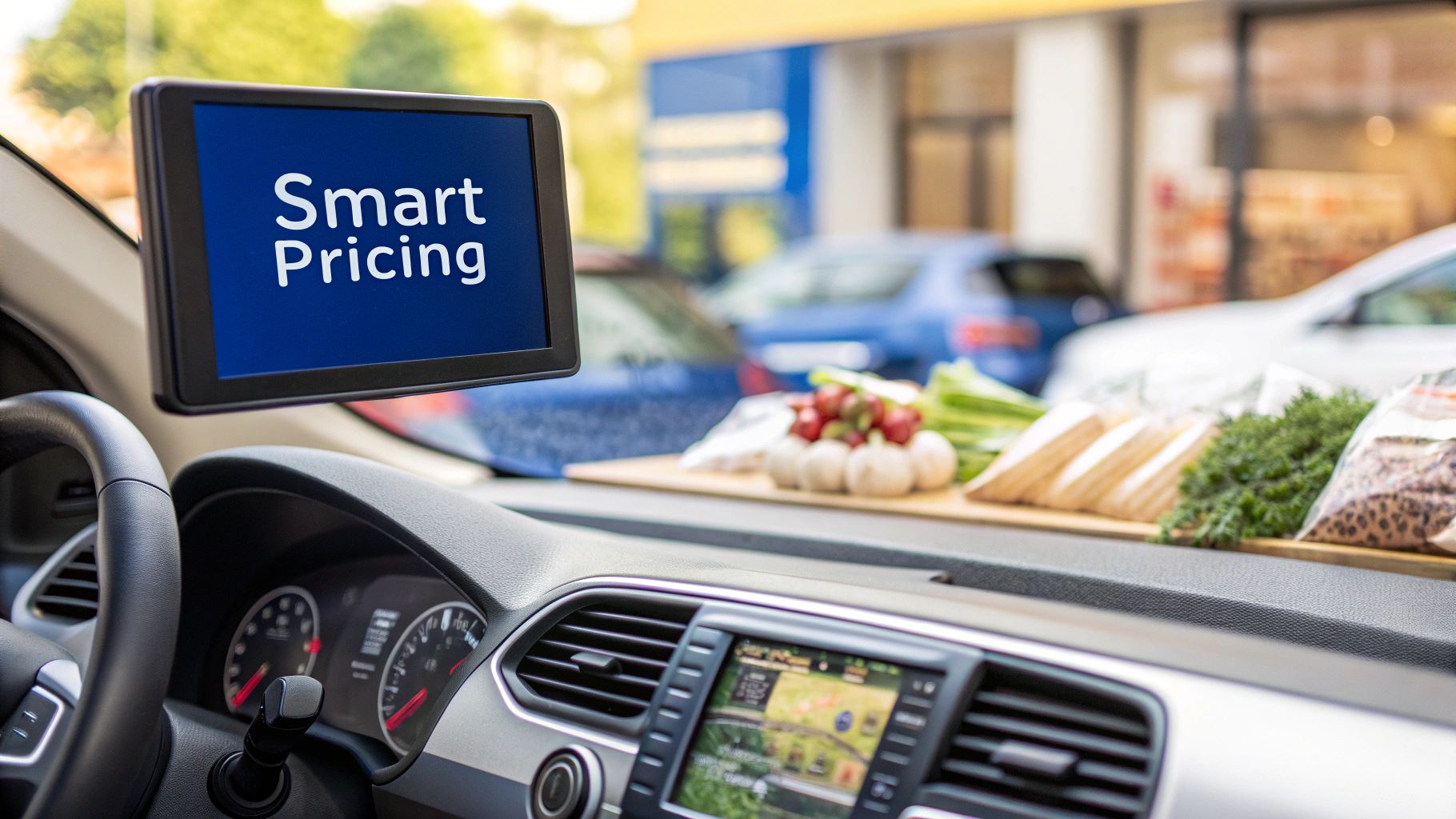How to Increase Amazon Sales by Treating PPC as a Growth Lever
Learn how to increase Amazon sales using our performance-first guide. We reveal data-backed strategies that use PPC to fuel organic growth and profitability.

To meaningfully increase Amazon sales, you must stop treating advertising and organic efforts as separate channels. The most powerful strategy is using paid advertising (PPC) to systematically fuel organic rankings. This creates a performance flywheel, a feedback loop that generates sustainable scale and profitability.
This isn't just another guide on how to get more sales; it's a strategic framework for eCommerce leaders focused on building lasting brand equity and market share on Amazon.
The Performance-First Playbook for Amazon Growth
Forget juggling disconnected tactics. Lasting growth on Amazon requires a unified system where every action builds momentum. The outdated model of siloing ads, listing optimization, and inventory management is a direct path to inefficiency and stalled growth.
Top-tier brands operate with a flywheel mentality. It’s a simple, powerful concept: strategic PPC spend kickstarts organic visibility. As organic rank climbs, ad efficiency improves, and total sales accelerate. This isn't about managing ACoS in a vacuum; it's about making a calculated investment in your product's long-term market position.
The prize is substantial. Amazon's U.S. e-commerce market share is a staggering 37.6% and growing. To capture a meaningful piece of this, a smarter, integrated strategy is non-negotiable.
The Amazon Growth Flywheel
What is this "growth flywheel"? It’s a continuous cycle where each component amplifies the next. This performance-first model looks like this:
Strategic Ad Spend: Drive initial traffic and sales with targeted Sponsored Products and Sponsored Brands campaigns. Every PPC-driven sale is a data point for Amazon's A10 algorithm, signaling your product's relevance for target keywords.
Building Sales Velocity: These initial PPC sales are critical. They prove to Amazon that customers searching for your keywords convert. This sales history is a primary ranking signal.
Climbing Organic Ranks: As sales velocity for target keywords increases, Amazon rewards you with higher organic search placement. This generates "free" clicks and sales, directly boosting your total profit margins.
Increasing Ad Efficiency: Higher organic rank improves ad performance, often leading to a lower cost-per-click (CPC) and a better Advertising Cost of Sale (ACoS). This frees up budget to target new keywords or defend top positions, spinning the flywheel faster.
This is a continuous loop of analysis, optimization, and performance tracking—not a "set it and forget it" tactic.

As the visual demonstrates, success on Amazon is a cycle of data-driven decisions and relentless optimization.
Expert Recommendation: Stop viewing advertising as a line-item expense. It is a strategic investment in your organic shelf space. Every dollar spent on a well-targeted ad must deliver an immediate sale and contribute to your long-term organic rank. This approach directly improves your marketing efficiency ratio (MER), a far better indicator of total business health than ACoS alone.
The Amazon Growth Flywheel at a Glance
This table illustrates how each component interconnects to drive measurable results.
| Component | Action | Performance Impact |
|---|---|---|
| PPC Advertising | Drive initial traffic and sales for high-intent keywords. | Generates immediate revenue and proves product relevance to Amazon's algorithm. |
| Sales Velocity | Increase units sold over a specific period for target terms. | Signals product popularity, triggering an organic ranking boost. |
| Organic Ranking | Achieve higher positions in non-paid search results. | Captures high-trust, "free" traffic and sales, increasing total profitability. |
| Ad Efficiency | Lower CPC and improve Total ACoS (TACoS). | Frees up the budget to reinvest into new keyword targets or scale campaigns, restarting the cycle. |
This flywheel isn't just a strategy; it's the core engine for building a scalable and profitable brand on the world's largest digital marketplace.
How PPC Fuels Your Organic Amazon Rankings
Judging Amazon Pay-Per-Click (PPC) campaigns solely on Advertising Cost of Sales (ACoS) is one of the most common and costly mistakes a brand can make. This treats advertising as a pure expense, completely missing its true strategic power.
Think of PPC as the primary lever you can pull to influence Amazon's A10 algorithm. It's not just about capturing a few incremental sales today; it's a direct investment in your product's long-term organic real estate. Every sale generated through a paid ad sends a powerful relevance signal to Amazon for that specific keyword.
This initial sales velocity is the rocket fuel for your organic rankings. It creates a powerful feedback loop: paid ads drive sales, which boosts organic rank, leading to more "free" traffic and sales.

Your PPC Toolkit for Driving Growth
Executing this strategy requires using the right tools for the right job. Amazon's ad types each play a distinct role in building organic presence.
Here's the strategic approach:
Sponsored Products: These are your workhorses for conquesting keywords. Start with an "auto" campaign to harvest real-world customer search terms. As high-converting terms emerge in your search term reports, move them to a "manual" campaign. There, you can bid deliberately to build sales history and aggressively pursue rank.
Sponsored Brands: These are for brand defense and category ownership. These banner ads are essential for owning your branded search terms, ensuring you—not a competitor—capture that high-intent traffic. They are also highly effective for driving shoppers to your Amazon Stores to increase average order value.
Sponsored Display: This is your retargeting engine. Re-engage shoppers who viewed your product but didn't convert. By serving them your ad again on and off Amazon, you recapture lost sales. Every recovered sale contributes to sales velocity and strengthens your ranking signals.
A Real-World Product Launch Example
Imagine launching a new high-performance blender. The average seller targets broad, expensive terms like "blender." A performance-minded seller executes differently.
You start with a hyper-focused Sponsored Products campaign targeting long-tail, high-intent keywords like "quiet smoothie blender for protein shakes" or "ice crushing blender for frozen fruit." Conversion rates are higher and CPCs are lower.
Simultaneously, a Sponsored Brands campaign targets your brand name and key competitor brands. This builds immediate recognition and defends your turf.
As sales data accumulates, your search term reports reveal a new winner: "blender for green juice." You immediately add this to your manual campaigns and bid to establish rank. It’s a methodical process of using paid data to inform your organic growth strategy.
Expert Recommendation: The primary goal of PPC is profitable data acquisition. Frame every campaign as a question: "Which keywords convert at the highest rate?" or "Can I profitably conquest this competitor's branded traffic?" The answers build your roadmap to page-one dominance.
Structuring Campaigns for Data and Profit
Campaign structure is critical. Dumping all keywords into one campaign creates messy data and wasted spend. Logical segmentation is key to control and insight. For a detailed guide on this, see our deep dive into Amazon PPC keyword research.
This integrated model is precisely how Amazon operates. Its staggering revenue growth isn't just from selling products. While product sales accounted for 41.1% of revenue in a recent quarter, service-based revenue streams like Prime subscriptions are booming. Amazon understands that creating an interconnected ecosystem drives exponential growth. As a seller, you must apply the same logic, tightly integrating your paid and organic strategies.
When you treat PPC as an investment in your organic future, you stop chasing short-term metrics and start building a sustainable, profitable asset. This flywheel is how you truly scale your brand on Amazon.
Get Your Digital Shelf Ready for Prime Time
Driving paid traffic to a product listing that isn’t optimized to convert is like filling a bucket with a hole in it—a fast track to wasted spend. The most sophisticated PPC campaign in the world won't save a listing that fails to close the sale.
Before scaling ad spend, ensure your "digital shelf" is "retail ready." This means every element is engineered to capture attention, answer pre-purchase questions, and make clicking "Add to Cart" an effortless decision. This isn't about keyword stuffing; it's about building a high-performance sales asset.

Weave Keywords into Compelling Copy
Great listings start with deep keyword research, but the output must be compelling copy, not a robotic list of terms. These keywords are the voice of your customer; weave them naturally into the fabric of your listing.
Your Title is Your Digital Billboard: This is your most valuable SEO and CTR real estate. A generic title like "Stainless Steel Water Bottle" is invisible. A performance-driven title like "BrandX 32oz Insulated Stainless Steel Water Bottle with Straw Lid - Keeps Drinks Cold for 24 Hours" is superior. It integrates keywords, brand, and a key benefit, driving higher click-through.
Bullet Points are for Scanners: Shoppers scan; they don’t read novels. Your five bullet points must be sharp, concise, and benefit-driven. Don't state a feature like "Made from 18/8 Stainless Steel." Translate it into a benefit: "Durable & Rust-Proof: Engineered with food-grade 18/8 stainless steel to ensure your water always tastes pure." Each bullet must address a potential objection or solve a customer problem.
Don't neglect backend search terms. This is your hidden keyword arsenal. Use this space for terms that don't fit in the frontend copy—common misspellings, competitor brand names, or foreign language equivalents of your top keywords. This is a simple, high-impact tactic to expand your reach.
Tell a Visual Story That Sells
On Amazon, your imagery and video are your salesperson. They must demonstrate the product, build trust, and drive the conversion. A couple of phone pictures is brand malpractice.
Deploy a strategic mix of visual assets:
- The Hero Image: A crystal-clear, high-resolution product shot on a pure white background. This is a non-negotiable Amazon requirement.
- Lifestyle Shots: Show the product in use. Help shoppers visualize it in their own lives. Selling a yoga mat? Show it being used in a well-lit, aspirational setting.
- Infographics: Use text overlays to call out key features, dimensions, or included components. This communicates critical information more effectively than a block of text.
- Comparison Charts: Visually compare different models or sizes side-by-side to reduce purchase friction and guide customers to the right choice.
- Product Video: A short, compelling video is the ultimate conversion tool. It can demonstrate usage, showcase features, and convey brand quality in under 60 seconds.
Expert Recommendation: Your main image is the single biggest lever for improving CTR. Use Amazon's "Manage Your Experiments" tool to A/B test variations. Test a different angle, show the product out of the box, or add a subtle graphic element. A 2-3% lift in CTR from a winning image can have a massive downstream impact on traffic, sales velocity, and organic rank.
Go Deeper with A+ Content
A+ Content is your brand's owned media space on the product page. Go beyond bullet points. Tell your brand story, provide a detailed "how-to" guide, or use a comparison module to cross-sell and upsell your catalog. Case Study: For a client in the competitive home goods space, we implemented a robust A+ Content strategy focused on comparison charts and lifestyle imagery. Within 60 days, their detail page conversion rate increased by 12%, demonstrating the direct impact of enhanced content on sales.
Treating your entire listing as a cohesive sales funnel is a core tenet of effective Amazon advertising optimization. When all elements work in concert, the traffic you pay for has the highest possible chance of converting, which in turn fuels the entire growth flywheel.
To move beyond transactional sales and build a defensible business, you must create a brand that customers remember, trust, and search for by name. This is the path to customer loyalty and repeat purchases.
The most powerful tools for this are Amazon Stores and A+ Content. Used correctly, they build a protective moat around your business, making it harder for competitors to poach customers. You are no longer just selling a product; you are curating a brand destination.

Treat Your Amazon Store Like a Flagship
Your Amazon Store is not a product grid; it is your flagship retail experience on the platform. It's your only opportunity to create a multi-page, immersive environment completely free of competitor advertising. This is where you control the narrative and the customer journey.
A high-performance Store requires a thoughtful structure:
- Homepage: Make a strong first impression with a hero image or video that communicates your brand promise. Feature new arrivals, best-sellers, and clear navigation to your key categories.
- Category Pages: Don't dump your entire catalog on one page. Organize products into logical collections to facilitate browsing and discovery, increasing the likelihood of a multi-item cart.
- “About Us” Page: Connect with customers on a human level. What is your origin story? What is your mission? Shoppers who connect with your story are more likely to become brand advocates.
A great Store requires traffic. Use Sponsored Brands ads to drive shoppers directly to your Store homepage or a curated category page. This is a more powerful play than driving to a single product, as it immerses them in your brand world and often leads to a higher average order value.
Transform Product Pages with A+ Content
If your Store is the brand's home, A+ Content brings that brand story directly to the product detail page. This section, located below the fold, is your opportunity to overcome objections, answer questions, and differentiate your product.
Using these modules strategically can significantly increase conversion rates. Don't just add more images; think like a marketer.
Key Insight: A+ Content is your secret weapon for answering a customer's unspoken questions. Is it easy to assemble? How does this compare to other models? Who is the company behind this? Answering these questions visually with A+ modules builds the confidence needed to convert.
Use the A+ modules to your advantage:
- Show, Don't Just Tell: Use high-quality graphics to visually deconstruct complex features. An infographic is always superior to a dense paragraph.
- Tell Your Brand Story: Dedicate a module to your company's mission or manufacturing process. This adds a human element to the digital shelf.
- Create Comparison Charts: This is one of the highest-impact A+ modules. A chart comparing your models helps customers self-select the right product, reducing returns and increasing satisfaction. It is also an excellent tool for upselling to premium options.
Investing in your brand on Amazon allows you to tap into a truly massive market. In a recent twelve-month period, Amazon's global revenue hit approximately $650 billion, a 10.08% increase year-over-year. You can explore more data on this incredible growth over at Macrotrends.net. This figure shows just how much opportunity there is for brands that can stand out and earn customer loyalty.
Ultimately, building brand equity is the most reliable way to increase Amazon sales. It makes your brand memorable, justifies a premium price point, and fosters the loyalty that turns first-time buyers into lifetime customers.
Get Your House in Order: Inventory and Pricing Are Your Growth Engine
You can execute a brilliant ad campaign, but if your operational backbone is weak, it's all for nothing. Experienced eCommerce leaders understand a critical truth: two of the most powerful levers for increasing Amazon sales are not in the ad console. They are inventory health and dynamic pricing.
Mastering these isn't just an operational task; it's a competitive advantage. A failure here undermines every dollar of ad spend. Driving paid traffic to an out-of-stock product or a listing that has lost the Buy Box is the equivalent of setting your marketing budget on fire.
The True Cost of an Empty Shelf
A stockout is one of the most destructive events for an Amazon business. The immediate lost sales are only the beginning; the real damage is long-term.
When your product goes out of stock, your sales velocity for your most valuable keywords drops to zero. This tells the A10 algorithm that your product is no longer a relevant solution. The organic rank you worked so hard to earn evaporates. In a competitive category, it can take weeks or even months of aggressive, expensive ad spend to reclaim that position.
This is why accurate forecasting is a core marketing function.
- Look Beyond Last Month's Sales: Analyze 30, 60, and 90-day sales velocity to understand your true trendline, accounting for any ad-driven sales spikes.
- Factor in Seasonality: Review year-over-year data to anticipate seasonal lifts. If you sell grilling tools, Q2 demand will differ vastly from Q4. Plan inventory months in advance.
- Monitor Your IPI Score Relentlessly: Your Inventory Performance Index (IPI) score in Seller Central is a critical health metric. A score above 400 grants you unlimited storage and protects you from restrictions during peak seasons like Q4.
The Smart Way to Price Your Products
Pricing on Amazon is a dynamic exercise, not a one-time decision. The market moves fast, and your pricing strategy must be agile. The goal is to win the Buy Box—where over 82% of sales occur—without engaging in a margin-destroying race to the bottom.
Manual repricing is impossible at scale, but a poorly configured automated tool is just as dangerous. A "win at all costs" repricer will simply undercut competitors by a penny until all profit is eroded.
Expert Recommendation: Smart pricing maximizes profitability, not just Buy Box ownership. Your repricing rules must be built to win the Buy Box at the highest possible price. This requires setting intelligent floor prices based on your true cost of goods sold (COGS) and ceiling prices based on market value.
A superior approach uses rules that react to market conditions. For example, if your primary competitor stocks out, your repricer should automatically increase your price to capture more margin. Conversely, if a new low-price seller emerges, it may nudge your price down to remain competitive, but it must never breach your pre-defined profit floor.
Tying It All Together for a Stronger Business
Operational excellence directly fuels sales growth when inventory management and pricing strategy are linked.
For example, if you know a new shipment is a week from the fulfillment center, you can price more aggressively to liquidate remaining stock, boost sales velocity, and avoid long-term storage fees.
Align your actions with this framework:
| Inventory Status | Your Pricing Strategy | The Goal |
|---|---|---|
| High Stock / Slow Mover | Price competitively. Deploy a coupon or Lightning Deal. | Improve sell-through rate to boost IPI and avoid storage fees. |
| Healthy Stock / Steady Seller | Use a smart repricer to own the Buy Box without sacrificing margin. | Maximize daily profit and maintain strong, consistent sales velocity. |
| Low Stock / Nearing OOS | Increase price slightly to decelerate sales. | Extend inventory life to prevent a full stockout and protect organic rank. |
When you treat inventory and pricing as interconnected components of your growth engine, you shift from a reactive to a proactive stance. This operational stability is the foundation upon which all successful advertising and brand-building initiatives are built.
Frequently Asked Questions for eCommerce Leaders
Let's address the most common questions that arise when brands begin implementing these performance-first growth strategies. Success on Amazon is determined by day-to-day execution.
How Quickly Can I Actually See Results From My PPC Campaigns?
The answer depends entirely on which "results" you're measuring.
You will see near-instant activity in metrics like impressions and clicks, but these are largely vanity metrics. The data that truly matters—the performance indicators that impact your P&L and drive sustainable growth—require patience.
- For initial optimization data: Allow a 30-day period. This gives the algorithm sufficient time to learn and provides you with a statistically significant data set to make intelligent decisions on bids and keyword harvesting.
- For strategic performance impact: Expect to see a clear, positive trend in your Total Advertising Cost of Sales (TACoS) and a corresponding lift in organic rank for targeted keywords within 60 to 90 days.
This is the timeframe where the flywheel effect becomes visible, as improved organic positioning begins to supplement and enhance your paid efforts. Consistent, data-backed optimization is the key.
Is Amazon DSP Worth It For a Brand My Size?
For a mid-to-large brand that has potentially saturated on-platform search advertising, the Amazon DSP (Demand-Side Platform) can be a powerful growth accelerator.
However, DSP is not a starting point. It is a scaling tool. You must first master your on-platform advertising. Once your Sponsored Products and Sponsored Brands campaigns are a finely tuned, profitable engine, DSP is the logical next step to expand your reach.
DSP unlocks advertising capabilities that standard PPC cannot:
- Prospect for new customers across the web on third-party sites and apps, leveraging Amazon's unparalleled first-party purchase and intent data.
- Execute sophisticated retargeting campaigns, reaching shoppers who viewed your products (or your competitors' products) but did not purchase.
- Build top-of-funnel brand awareness, filling your pipeline with new customers who will later search for you by name.
The investment for DSP is significant. Entering without clear, measurable goals is a fast path to burning budget. View it as a powerful tool for scaling an already successful program, not fixing a broken one.
What's the Single Biggest Mistake Brands Make on Amazon?
The single most common and costly mistake is organizational siloing. Brands treat their Amazon efforts as a series of disconnected tasks.
One team manages PPC. Another handles listing content and A+ pages. A third department manages the supply chain. They all operate in isolation, blind to how their actions impact one another.
This siloed thinking leads to predictable and painful errors:
- Wasting thousands in ad spend driving traffic to an out-of-stock product, which tanks ad performance and destroys organic rank.
- Winning bids for keywords that are not present on the product detail page, resulting in abysmal conversion rates.
- Launching a major promotion without informing the supply chain team, causing a stockout that erases weeks of ranking progress.
The No-Nonsense Takeaway: Winning on Amazon isn't about excelling at one discipline. It’s about operational excellence across the board. Your advertising, your content, and your supply chain must function as a single, cohesive growth engine.
Breaking down these internal silos is the first and most critical step to unlocking your brand's true potential on the platform.
At Headline Marketing Agency, we don't operate in silos. Our methodology is built on the tight integration of performance-first advertising, conversion-focused content, and critical operational intelligence. We build a single, cohesive growth engine for your brand. If you’re ready to move beyond disconnected tactics and build a sustainable, profitable business on Amazon, let's connect.
Ready to Transform Your Amazon PPC Performance?
Get a comprehensive audit of your Amazon PPC campaigns and discover untapped growth opportunities.